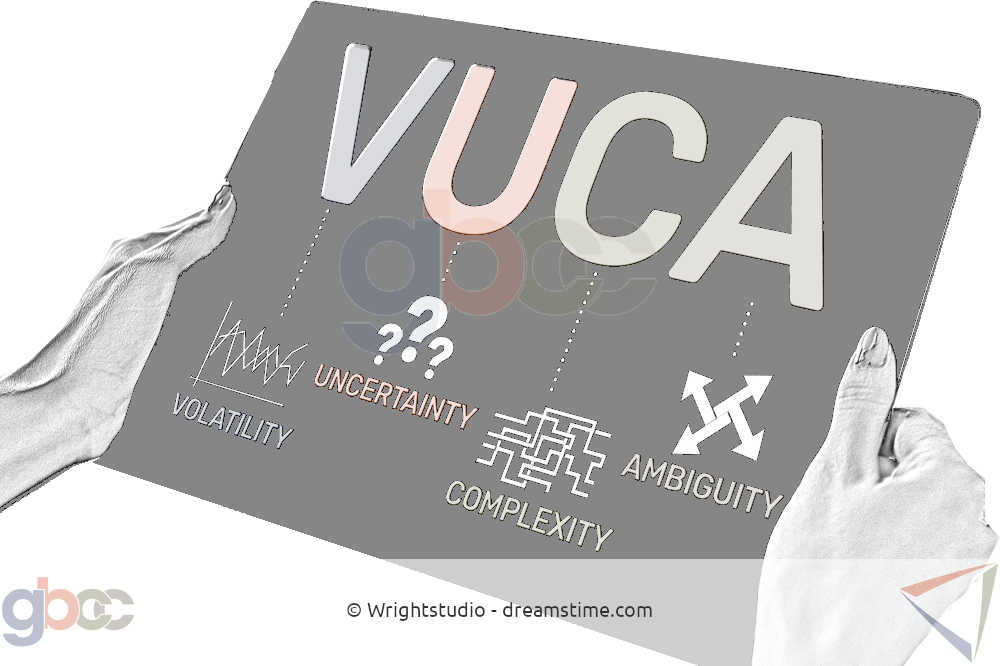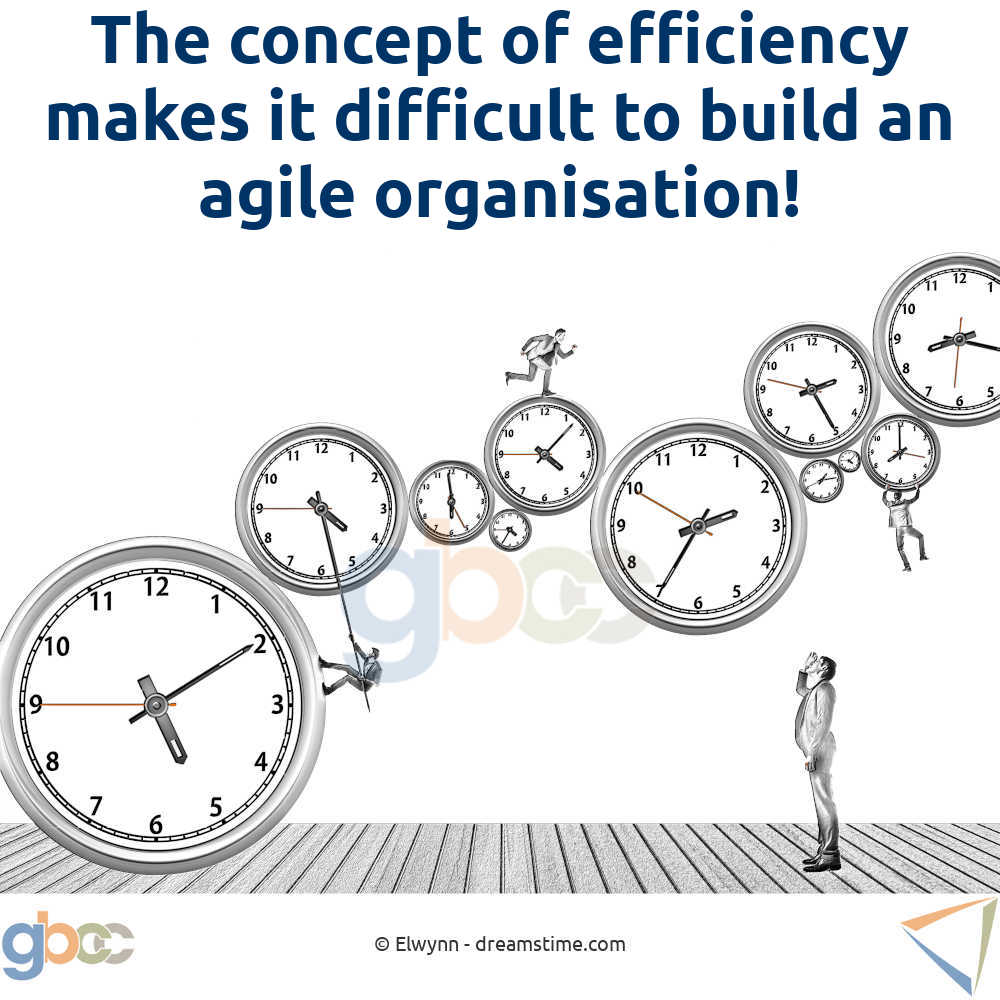Increasing efficiency is essentially the topic on the radar of all business leaders. However, the implicit assumptions do not match the requirements to survive in a complex and increasingly uncertain market environment.
- Part 1: Effectiveness vs. organisational structure
- Part 2: Efficiency vs. agility
- Part 3: Productivity/economic profitability vs. period thinking
- Part 4: Strategic uncertainty vs. economic profitability
In the first part of this series of articles, we looked at the effectiveness of activities and critically examined the inglorious role of the organisational structure. In this part, we deal with the efficiency.
Efficiency (doing things right)
Working efficiently means working in such a way that the means used (working time and materials) and the outcome achieved result in a favourable cost-benefit ratio.
If efficiency is to be increased, then solutions are sought so that employees can achieve the intended output even faster or with even less effort.
Increasing efficiency is the main topic that is on the radar for company leaders, their consultants, and their service providers. Digitalisation and automation measures, just-in-time production, lean management – numerous approaches that seemingly promise efficiency.

This would not be at all objectionable if they did not regularly ignore the associated imponderables, because that, in turn, often ensures that companies merely burn money efficiently!
1. Even the most efficient activity wastes time, effort, and cost if it is ineffective.
- A company can develop and produce a product fully digitised, optimally automated, lean, and fast. If no one needs and/or buys it, it was all in vain. The battle was won, but not the war.
- The same is true if a company does not have a sustainable use of resources and corporate development in mind, but only short-term profit maximisation and satisfaction of needs, thereby putting the future of the company at risk.
2. An employee’s working time is allocated 100% to their skilled work, even though they have administrative and other tasks to perform that are also important for the company’s success.
- For example, if a programmer’s working time is completely allocated to “programming” and their output is judged according to this, the likelihood that they will neglect their administrative tasks increases.
- It takes time to train a new colleague; time which will be lacking in one’s own work. Together with the new colleague’s lack of routine, these factors cause a decrease in the efficiency of the unit – hopefully, only for a short time. Does the unit nevertheless take enough time for this task?
3. The potential costly consequences of measures used to increase efficiency are not considered.
- Suppose employees feel massive pressure over long distances to work faster and/or longer to increase their output. This simultaneously increases the likelihood that costly mistakes will occur, sick days in the company will increase, and quiet quitting (including normal resignations) will increase.
Efficiency in a complex and uncertain market environment
Just 20 years ago, it was difficult for customers to find out what was happening in the suppliers’ and service providers’ markets and what alternative solutions were available. Customers had to conduct lengthy market research if they wanted to actively replace their current supplier/service provider.
Therefore, traditional corporate governance worked quite well: a company could consider market and customer behaviour to be relatively stable over long periods of time.
The company was able to set its own target, and the milestones to this target, in a process-oriented manner. It was able to set key performance indicators to measure the progress or level of achievement of the objectives.

And it was able to work undisturbed and in peace on organising the path to its self-chosen goal in a streamlined manner. It did this primarily through good price negotiations with suppliers, and it put pressure on its own employees to work faster and longer.
Later, over the course of the “digitisation” of the economy, the company gained access to affordable software solutions that made it easier to plan processes more leanly; to exchange data internally more securely and efficiently; and to check the efficiency of its employees’ work.
Quality management, including ISO certification, is also based on the logic of traditional corporate management. It deals with the processes that take place in one’s own company. A company with a lot of purchasing power can, at most, order its own suppliers to be certified as well. But not its customers!
Since the beginning of the internet age, however, customers are much better informed. The market has become more transparent. Information is easier to access and to evaluate. Consequentially, the first industry to have a rude awakening was the software industry.

They noted: “We need more than 1 year to bring a new product to market. If we only find out at launch that customers’ requirements have changed and our product does not meet those requirements, then we have probably worked ineffectively for more than 1 year and wasted resources. No matter how efficiently we worked during that time.”
Influence of agility on effectiveness and efficiency
This is the transition to agile management: the ability to still operate profitably in an environment characterised by unpredictable and changing customer needs. For this, it is necessary to be able to act flexibly, proactively, and anticipatorily in constant exchange with customers.
A company does not become “agile” just because it has sent its programmers on training courses, and they now plan “sprints”. The company only becomes agile when owners/managers themselves have recognised that their previously preferred values are no longer relevant in their market. Their customers now expect other values from them: flexibility, a quick reaction to requests for change, and adaptability.
When a company is agile in an environment where customer requirements are constantly changing, it uses its resources EFFECTIVELY, because the company’s output is valued and accepted by the customer!
However, if in such a market environment, the company continues to set up detailed, meaningful, functional specification documents during contract negotiations to set up predictable and efficient processes, then the company will perceive any request for change from its clientele as a “disruption of normality”.
A disruption that costs money because it makes the EFFICIENT use of resources impossible. And here we come full circle to the statement at the beginning: efficient activities that are ineffective are a waste of money. A realisation that some industries still have ahead of them.
Agile IT projects for the construction industry: squaring the circle
Agile IT project orders are quite popular these days. The idea that the contractor (CO) is in constant exchange with the client (CL) to plan “sprints” together, and that ongoing change requests are always considered, sounds very promising.
However, software producers who serve the construction industry have a particularly hard time. The problem here is that the CL, from the construction industry, would like to have the flexibility of an agile order coupled with the fixed-price planning security of a thoroughly calculated project according to the waterfall approach.

Their internal decision-making bodies just don’t know any better because the construction industry itself is still organised in a classic project-oriented way. The biggest challenge of the construction industry is to take the unpredictable into account in its sequential planning.
The basic premise is that the construction company asks for the client’s wishes, then plans the project in detail, and carries it out without any deviations. If the client “exceptionally” expresses the wish for a change of objectives, then the process is recalculated, and a new offer is made.
Construction projects are characterised by unpredictable and changing customer requirements
This is a completely distorted perception of reality, because, in my opinion, the basic premise has never been and never will be true. The construction industry faces similar challenges to the IT industry. To put it provocatively, a builder who:
- Knows themselves exactly and what they actually want,
- Takes the time to adequately communicate and remembers what they want, and
- Sticks to what they originally wanted has yet to be found.
The problem of constantly changing customer requirements is compounded by the system-inherent unreliability of crafts and other construction participants. Material delivery bottlenecks are currently adding to the problem. All this leads to cost overruns and schedule delays. And this is the rule, not the exception.
Fact: the approach of planning projects sequentially through to the end ties up considerable resources before the actual construction can even begin. In many cases, the plan must be revised several times before the execution phase begins due to changes in the client’s project requirements. This approach is neither effective nor efficient.
Agile construction projects are the order of the day
The construction industry and its players would therefore be well advised to adopt an agile mentality and way of working. Sprint planning should be the order of the day. As an aside, the construction industry is also familiar with the process of “construction-accompanying planning”, where the next step on the construction site is neither planned, let alone prepared. From the construction industry’s point of view, this is a highly inefficient way of working – but from the client’s point of view, a thoroughly agile one!
Both approaches, that of quality management and that of efficiency, would have to be rethought and adapted for an agile way of working. A new approach that consciously considers that processes continuously move back and forth between several companies, and “process owners” permanently take turns until all those involved achieve the desired end result together.
This makes it all the more exciting that the conservative construction industry, of all sectors, has developed Building Information Management (BIM) as a workable methodology to ensure quality and efficiency assurance for all companies involved – from subcontractors to product suppliers to construction companies.
The next article will continue with “productivity” and “economic profitability”. These are usually determined based on periodic data. However, what really happens in companies happens in processes and not in periods.
- Part 1: Effectiveness vs. organisational structure
- Part 2: Efficiency vs. agility
- ➟ Part 3: Productivity/economic profitability vs. period thinking
- Part 4: Strategic uncertainty vs. economic profitability

